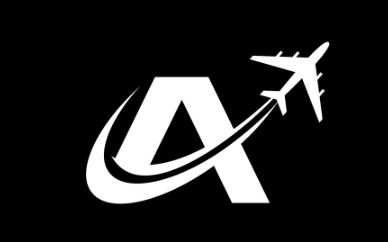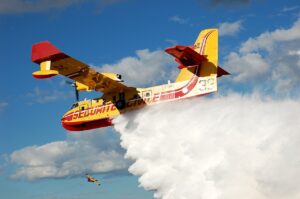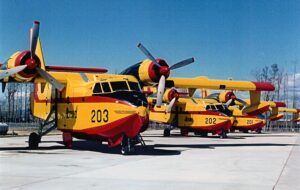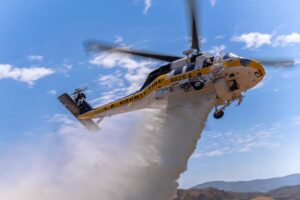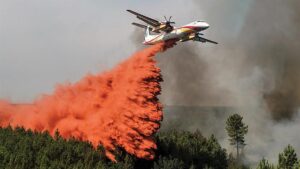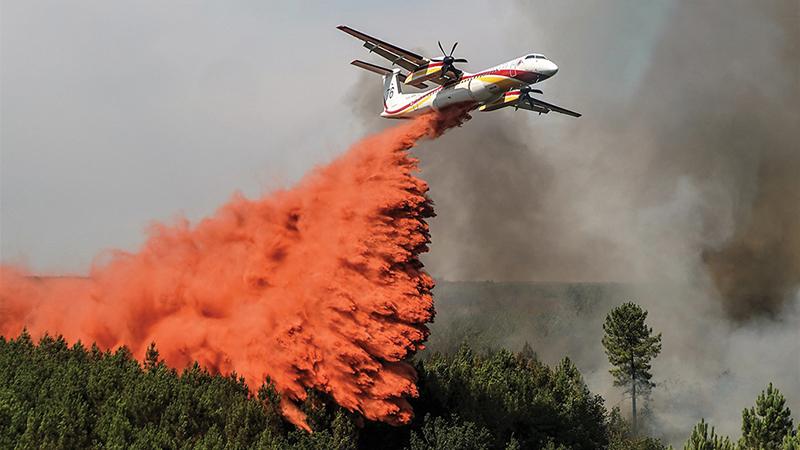
By: Tony Osborne
After relying for decades on fleets of 1950s and ’60s-era aircraft, the firefighting industry is introducing new technologies and fleets to make their operations safer, more effective and ready to meet growing demand.
The wildfire threat is worsening and is increasingly a year-round concern. Aerial-firefighting insiders no longer talk of fire seasons but rather of fire years, requiring aircraft to be available for dispatch throughout the year.
Montana-based Bridger Aerospace announced that it had sent an aircraft to combat forest fires in Oklahoma in February, the earliest dispatch in its history. In Europe, wildfires began in Greece in April.
EU figures show that wildfires in Europe in 2023 consumed an area roughly twice the size of Luxembourg—equivalent to more than 500,000 hectares (1.2 million acres) of land—in one of the worst years for wildfires on the continent since 2000.
Multiple studies link the amount and increasing severity of wildfires with climate change—higher temperatures, warmer springs as well as longer summer dry seasons with drier or drought-ridden soil and vegetation are lengthening fire seasons.
“Places that we’ve never seen fires are starting to have fires, and some of these are real problem fires—the burns are larger, more severe than ever,” John Gould, president of the United Aerial Firefighting Association and president and CEO of 10 Tanker, a New Mexico-based operator flying converted McDonnell Douglas DC-10s, tells Aviation Week. Deployment of aircraft to such countries as Australia are now more regular than they were 10 years ago, while in Europe firefighting aircraft have been positioned in Germany and Sweden, nations that did not need such a capability five years ago.
There is no single correct way to fight a fire, and some fires will demand a range of assets, Coulson Group President and Chief Operating Officer Britton Coulson says. The company’s firefighting aircraft range from Sikorsky UH-60 Black Hawk and Boeing CH-47 Chinook helicopters to adapted Lockheed C-130 Hercules and Boeing 737 airliners.
“You’ll hear people talk about a range of tools in the toolbox,” Coulson says. “Rotary-wing and scoopers [amphibians] will go direct-attack on the fire, whereas large land-based air tankers typically will go indirect, dropping retardant in front of the fire to stop it from spreading.”
The growing impact of wildfires on national economies is prompting governments to expand firefighting capacity, increasingly contracting for capability or buying new fleets of aircraft for their civil agencies and air forces.
New Super Scoopers
A major modernization effort is underway in Europe, where six countries are in the process of acquiring the De Havilland Canadair 515, the latest development of the distinctive Canadair CL-215 family of firefighting amphibians. De Havilland Canada changed the amphibian’s marketing name in October to recognize its commonly used Canadair name.
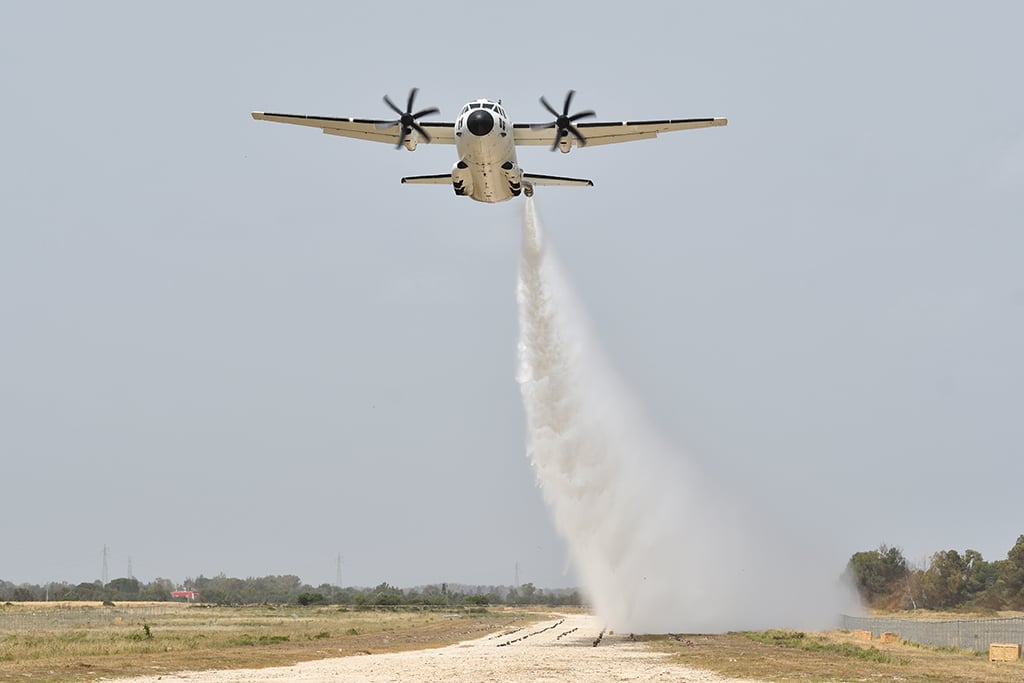
A joint procurement of 22 aircraft by Croatia, Greece, France, Italy, Portugal and Spain has financial support from the European Commission. The funding has enabled De Havilland Canada to restart production of the aircraft, eight years after Viking Air—now part of De Havilland Canada—purchased the type certificate for the CL-215 family and nine years since the last CL-415 rolled off the production line.
De Havilland Canada tells Aviation Week it is now producing parts and ordering components from suppliers to support production for the European orders.
Changes from the turboprop CL-415 will not be significant, however. The DHC-515 will use the same airframe as the earlier models, albeit with changes to improve the aircraft’s reliability and corrosion resistance. It will feature a new avionics suite, provided by Universal, as well as improvements to the air-conditioning system and water drop controls.
Because the DHC-515 is using the same airframe, it will retain the existing type certificate; De Havilland Canada is pursuing supplementary type certificates for those changes. The company has not said which engine the aircraft will use, but given the low-risk efforts, the Pratt & Whitney Canada PW123AF—which powered the CL-415—is the most likely option.
De Havilland Canada expects some fleet growth in the coming years due to wildfire trends. About 160 CL-215s and CL-415s are in service. The company expects to replace and augment these with more DHC-515s, envisaging a global fleet of about 200 aircraft in the coming years.
De Havilland Canada says it is “beginning to engage with other current and potential operators” to secure additional orders for the aircraft.
Firefighting operators, however, say the use of dedicated amphibian firefighting aircraft is expensive, and their usefulness ultimately depends on the fire’s geography. If the fire is close to open water, amphibious aircraft can be game-changing in terms of the amount of water they can deliver. Their effectiveness fades with distance from the water source, however, since the area dropped on could dry out and start to burn again.
In addition, the aircraft can truly be used for only one mission. Some industry insiders note that large helicopters, such as converted CH-47s, can and are increasingly taking on the role of the amphibians and carrying similar amounts of water. Another advantage of helicopters is that they can also carry retardant and be used at night, unlike many fixed-wing platforms.
Adapting Airlifters
Industry increasingly recognizes that some of amphibians’ perceived shortcomings are making the adaptation of existing land-based aircraft a more attractive proposition.
Airbus, Embraer and Leonardo have all adapted their airlifters for the firefighting mission as a potential new capability.

Leonardo has been testing a palletized, roll-on/roll-off version of United Aeronautical Corp.’s (UAC) Modular Aerial Fire Fighting System (MAFFS) 2 and has already secured a first customer for the configuration.
MAFFS has long been associated with the C-130 and extensively used by U.S. Air National Guard units for firefighting since the 1970s, but the system is now being modernized and adapted for other platforms.
MAFFS consists of a series of palletized tanks and pumps that can deliver water or retardant through an S-duct installed in the paratroop door on the side of the aircraft and then deliver those at a variable rate. Use of the S-duct is particularly important because it cleanly separates the delivery of liquid away from the aircraft; some fire retardants can be corrosive to aircraft skins.
Prior to the development of MAFFS 2 for the Alenia C-27J, Leonardo had experimented with a more austere system. The Caylym Guardian system used boxes full of water that would burst on impact with the ground—firebombing at its most basic.
By comparison, the C-27J’s MAFFS 2 can deliver about 7,500 liters (1,980 gal.) of water or retardant onto a fire and can be installed onto or removed from the aircraft in about 90 min., says Christian Amendolagine, senior vice president of Leonardo’s Airlifters and Special Versions business.
New Skills
“Our platform is a very capable and highly performing platform, and our analysis suggested that a firefighting capability could be a complementary solution with aircraft like the Canadairs,” Amendolagine notes.
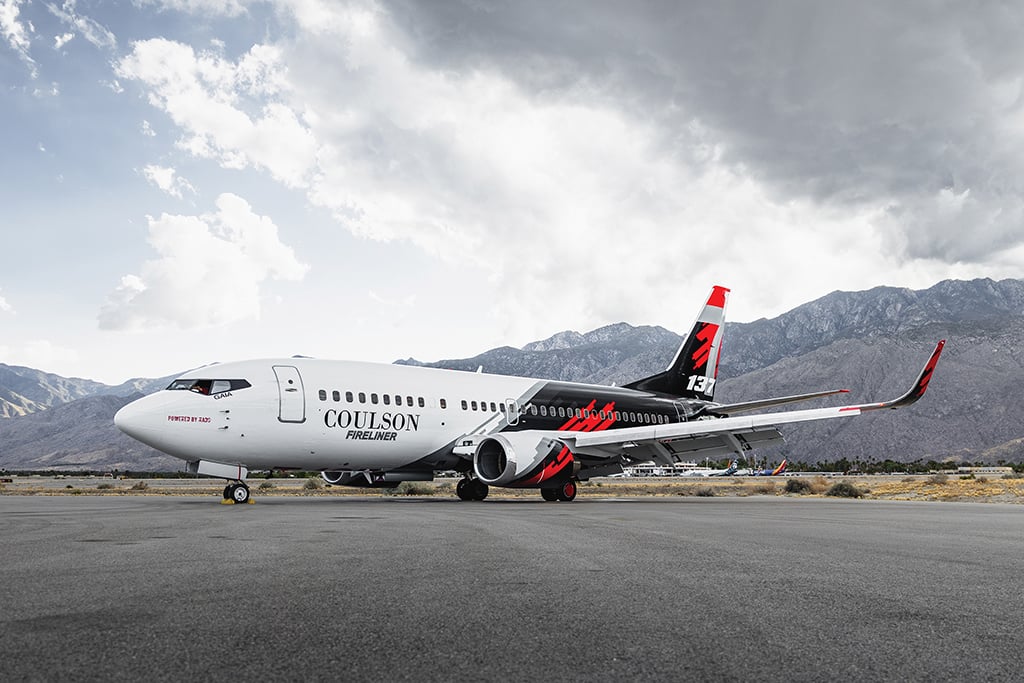
Installation of the 2-metric-ton MAFFS kit requires no modifications to the aircraft apart from adding some switches in the cockpit to operate the system and modifying the existing paratroop doors so the MAFFS nozzle can be fitted. The system has already been tested in flight trials in Grottaglie in southern Italy and at Leonardo Aircraft’s facilities in Turin.
The engineering team proved that the aircraft was able to demonstrate in full a coverage level of six (CL6)—a measure of the number of gallons delivered in a 100-ft.2 area—and was close to CL8. Amendolagine says adding firefighting capability to the C-27J will add another feather to the aircraft’s cap and make it more attractive to operators seeking a multimission aircraft.
For many military and commercial customers, an aircraft dedicated to firefighting but performing that mission only part of the year is a less attractive investment.
“The fact that the C-27J is reconfigurable is a strength of our offer. . . . You can remove a kit and install another kit very quickly,” says Tommaso Pani, senior vice president of marketing and strategic campaigns at Leonardo Aircraft. “Our strategy was not to sell the aircraft just for firefighting. . . . Our business approach [is that] the aircraft can do multiple missions.”
Balkan Needs
Leonardo has already sold the MAFFS 2 with the C-27J ordered by Slovenia, part of a wider investment by Ljubljana after a series of wildfires in the Balkan state destroyed property and homes over thousands of hectares of land. Mostly landlocked and with a paucity of large lakes for amphibians to land on, Slovenia is dependent on land-based firefighting aircraft. Leonardo says the C-27J keeps its rough field performance and has demonstrated the ability to refill the MAFFS 2 tanks in just 15 min.
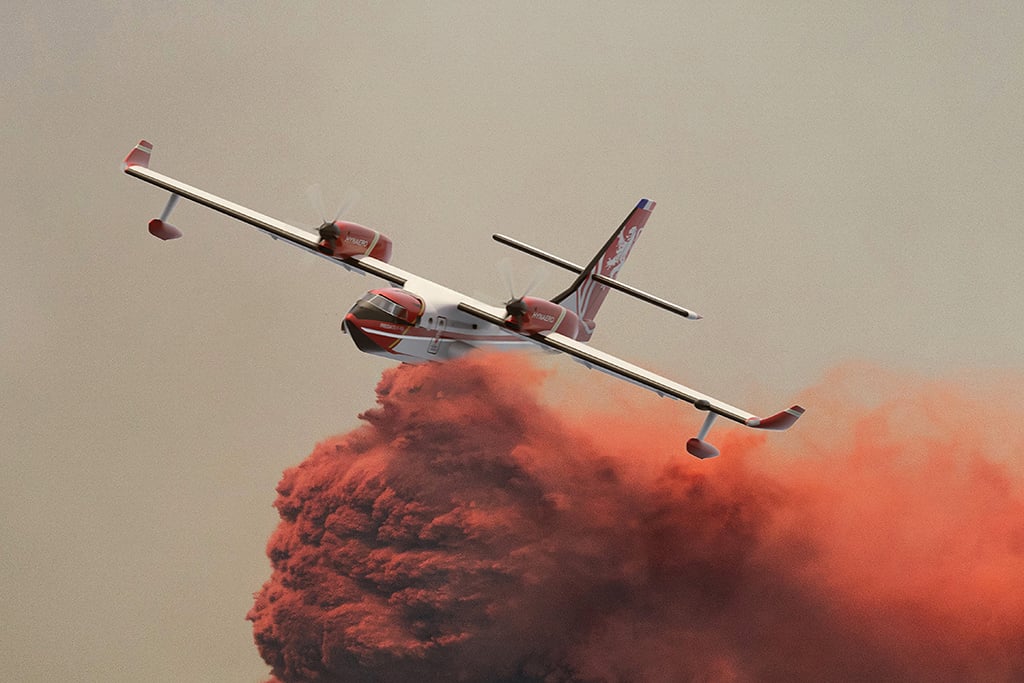
The next steps for the development of the C-27J MAFFS 2 are to trial the system on real, albeit controlled fires, in conjunction with Italian authorities before initial certification early next year. Full certification is planned for the end of 2025, paving the way for civil operators to acquire the aircraft and the kit, as the C-27J has a European Union Aviation Safety Agency type certificate.
Airbus has previously demonstrated a firefighting capability for its twin-turboprop C295 and, more recently, for its A400M. Jean-Brice Dumont, head of air power at Airbus Defense and Space, said at the Farnborough International Airshow in July that a firefighting A400M could deliver 20 metric tons of water onto a fire by day or night.
“This could be a complement or an additional capability to the traditional scooping Canadairs,” Dumont said. He added that Airbus was discussing how the mission could be further developed with customer nations.
Embraer also worked with UAC on a MAFFS 2 for the KC-390 capable of dropping about 12,000 liters of water or retardant. That system has been in regular use in recent weeks during Operation Pantanal II, combating wildfires in the Mato Grosso do Sul region of Brazil. On Aug. 19, the Brazilian Air Force reported its MAFFS-equipped KC-390s had delivered about 1 million liters of water onto the fires since late June.
Fireliner Evolution
Buying new aircraft is an expensive outlay for commercial operators, so many companies turn instead to conversions of existing aircraft. Among the most radical programs underway is that by Coulson, which has begun converting Boeing 737-700s to what the Canadian company calls 737 Fireliners, building on its earlier experience adapting Boeing 737-300s.
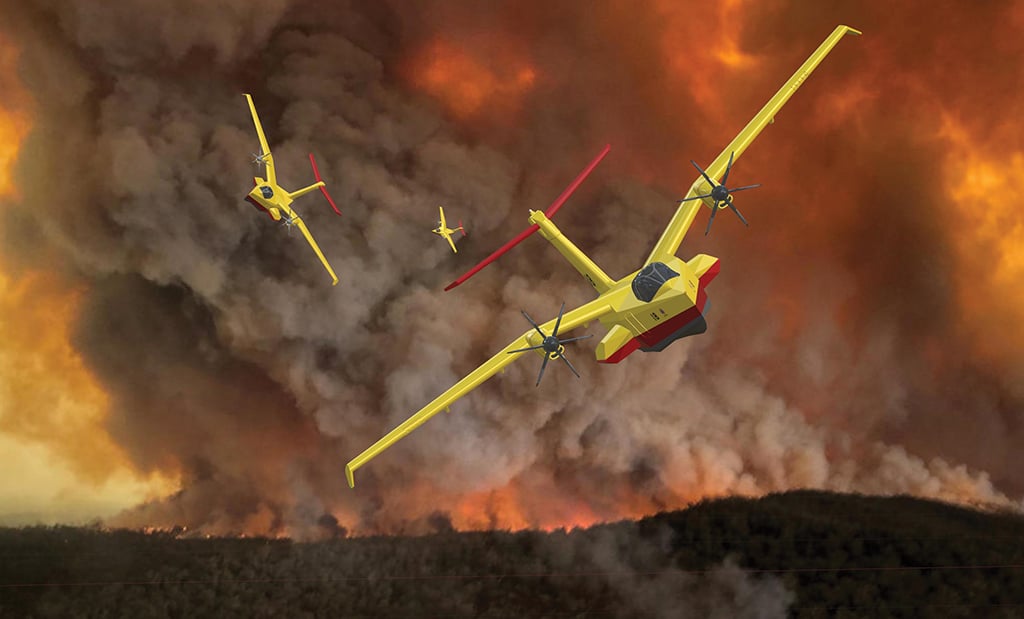
Coulson’s first 737-700—a former Southwest Airlines aircraft—was inducted into the company’s facilities in May. That aircraft will be outfitted with Coulson’s Retardant Aerial Delivery System (RADS) to make it capable of carrying 19,000 liters of water or retardant, about 4,000 liters more than that carried by the 737-300 versions.
“[The 737-700] is the large air tanker of the future,” Coulson notes. “When you look at an aircraft like a 737, there’s so much you can do with it. . . . It can go at a moment’s notice anywhere in the world and perform other tasks when not being used for firefighting.”
The changes do not affect the aircraft’s cabin, which can still be pressurized and carry passengers when required. Following the early success with conversions of 737-300s, two Fireliners were sold to governments, one to the Argentine province of Santiago del Estero and another to the New South Wales Rural Fire Service, the latter operated for them by Coulson’s Australian business.
Coulson says he expects even more success from the -700 variant—particularly given the life left in the aircraft as well as the large number of airframes and potential spare parts sources available for operators.
“The 737 is the longest produced commercial airliner in the world,” Coulson adds. “Most countries have one or two 737 local operators, and there will always be local people who can be hired to fly and maintain it. . . . It is the perfect aircraft for a government agency.”
Engineering on the -700 airframe has been underway for the past 18 months and before delivery of the first aircraft, Coulson notes. The company’s engineers, he says, have been “fine-tuning” the design and “incorporating numerous other improvements that are going to make it easier and faster to manufacture.” He adds that the demand signals suggest that more orders will follow.
The company has also converted former U.S. Coast Guard Lockheed HC-130Hs to a firefighting configuration for the California Department of Forestry and Fire Protection. In Canada, conversions of Dash-8 Q400s continue by Conair, and adaptations of Air Tractor AT-802 as light air tankers are becoming increasingly popular as a cost-effective system.
Future Thinking
In Europe, three startups are exploring the development of new-generation amphibians for aerial firefighting. France’s Hynaero is proposing a twin-turboprop amphibian called the Fregate-F100 that could deliver 10,000 liters of water onto a fire. Belgian Roadfour’s Seagle proposal would deliver 12,000 liters and use fly-by-wire controls and composite materials. Italian company 19-01 is proposing its WF-X Waterfall amphibian design to deliver approximately the same amount of water. Hynaero has already begun fundraising rounds and predicts it could have its aircraft in the air by 2031.
China’s Avic AG600 four-engine amphibian has also been designed to deliver 12,000 liters of water onto fires, but development of the platform has come at a slow pace.

Based in London, Tony covers European defense programs. Prior to joining Aviation Week in November 2012, Tony was at Shephard Media Group where he was deputy editor for Rotorhub and Defence Helicopter magazines.
SOURCE: https://aviationweek.com/aerospace/aircraft-propulsion/new-generation-aircraft-development-aerial-firefighting-mission
